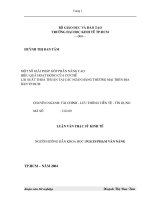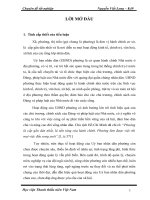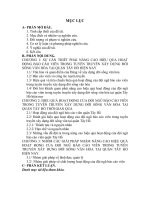Performance management 2009
Bạn đang xem bản rút gọn của tài liệu. Xem và tải ngay bản đầy đủ của tài liệu tại đây (2.9 MB, 703 trang )
THE
Professional Practice
S
E
R
I
E
S
James W. Smither
Manuel London
EDITORS
Performance
Management
Putting Research
into Action
A Publication of the Society for
Industrial and Organizational Psychology
Performance Management
The Professional Practice Series
The Professional Practice Series is sponsored by The Society for
Industrial and Organizational Psychology, Inc. (SIOP). The series was
launched in 1988 to provide industrial and organizational psychologists,
organizational scientists and practitioners, human resources professionals,
managers, executives and those interested in organizational behavior and
performance with volumes that are insightful, current, informative
and relevant to organizational practice. The volumes in the Professional
Practice Series are guided by five tenets designed to enhance future
organizational practice:
1. Focus on practice, but grounded in science
2. Translate organizational science into practice by generating guidelines, principles, and lessons learned that can shape and guide
practice
3. Showcase the application of industrial and organizational psychology to solve problems
4. Document and demonstrate best industrial and organizationalbased practices
5. Stimulate research needed to guide future organizational practice
The volumes seek to inform those interested in practice with
guidance, insights, and advice on how to apply the concepts, findings,
methods, and tools derived from industrial and organizational
psychology to solve human-related organizational problems.
Previous Professional Practice Series volumes include:
Published by Jossey-Bass
Customer Service Delivery
Lawrence Fogli, Editor
Employment Discrimination Litigation
Frank J. Landy, Editor
The Brave New World of eHR
Hal G. Gueutal, Dianna L. Stone, Editors
Improving Learning Transfer in Organizations
Elwood F. Holton III, Timothy T. Baldwin, Editors
Resizing the Organization
Kenneth P. De Meuse, Mitchell Lee Marks, Editors
Implementing Organizational Interventions
Jerry W. Hedge, Elaine D. Pulakos, Editors
Organization Development
Janine Waclawski, Allan H. Church, Editors
Creating, Implementing, and Managing Effective Training and
Development
Kurt Kraiger, Editor
The 21st Century Executive
Rob Silzer, Editor
Managing Selection in Changing Organizations
Jerard F. Kehoe, Editor
Evolving Practices in Human Resource Management
Allen I. Kraut, Abraham K. Korman, Editors
Individual Psychological Assessment
Richard Jeanneret, Rob Silzer, Editors
Performance Appraisal
James W. Smither, Editor
Organizational Surveys
Allen I. Kraut, Editor
Employees, Careers, and Job Creating
Manuel London, Editor
Published by Guilford Press
Diagnosis for Organizational Change
Ann Howard and Associates
Human Dilemmas in Work Organizations
Abraham K. Korman and Associates
Diversity in the Workplace
Susan E. Jackson and Associates
Working with Organizations and Their People
Douglas W. Bray and Associates
Performance Management
Join Us at
Josseybass.com
Jo
Register at www.josseybass.com/email
for more information on our publications,
authors, and to receive special offers.
Performance
Management
Putting Research
into Action
James W. Smither and
Manuel London, Editors
Copyright © 2009 by John Wiley & Sons, Inc. All rights reserved.
Published by Jossey-Bass
A Wiley Imprint
989 Market Street, San Francisco, CA 94103-1741—www.josseybass.com
No part of this publication may be reproduced, stored in a retrieval system, or transmitted in any form
or by any means, electronic, mechanical, photocopying, recording, scanning, or otherwise, except as
permitted under Section 107 or 108 of the 1976 United States Copyright Act, without either the prior
written permission of the publisher, or authorization through payment of the appropriate per-copy fee
to the Copyright Clearance Center, Inc., 222 Rosewood Drive, Danvers, MA 01923, 978-750-8400, fax
978-646-8600, or on the Web at www.copyright.com. Requests to the publisher for permission should
be addressed to the Permissions Department, John Wiley & Sons, Inc., 111 River Street, Hoboken, NJ
07030, 201-748-6011, fax 201-748-6008, or online at www.wiley.com/go/permissions.
Readers should be aware that Internet Web sites offered as citations and/or sources for further
information may have changed or disappeared between the time this was written and when it is read.
Limit of Liability/Disclaimer of Warranty: While the publisher and author have used their best efforts
in preparing this book, they make no representations or warranties with respect to the accuracy
or completeness of the contents of this book and specifically disclaim any implied warranties of
merchantability or fitness for a particular purpose. No warranty may be created or extended by sales
representatives or written sales materials. The advice and strategies contained herein may not be
suitable for your situation. You should consult with a professional where appropriate. Neither the
publisher nor author shall be liable for any loss of profit or any other commercial damages, including
but not limited to special, incidental, consequential, or other damages.
Jossey-Bass books and products are available through most bookstores. To contact Jossey-Bass directly
call our Customer Care Department within the U.S. at 800-956-7739, outside the U.S. at 317-572-3986,
or fax 317-572-4002.
Jossey-Bass also publishes its books in a variety of electronic formats. Some content that appears in
print may not be available in electronic books.
Library of Congress Cataloging-in-Publication Data
Performance management : putting research into action / James W. Smither and Manuel
London, editors.
p. cm.—(The professional practice series)
Includes index.
ISBN 978-0-470-19232-0 (cloth)
1. Career development. 2. Employee motivation. I. Smither, James W. II. London,
Manuel.
HF5549.5.C35P45 2009
658.3'128—dc22
2009013926
Printed in the United States of America
first edition
HB Printing
10 9 8 7 6 5 4 3 2 1
The Professional Practice Series
SERIES EDITORS
Allan H. Church
PepsiCo Inc.
Janine Waclawski
Pepsi-Cola North America
EDITORIAL BOARD
Timothy T. Baldwin
Indiana University, Bloomington
Wayne F. Cascio
University of Colorado
Kenneth P. De Meuse
University of Wisconsin, Eau Claire
Jerry W. Hedge
Personnel Decisions Research Institute, Inc.
Catherine Higgs
Allstate Insurance Company
Kenneth Pearlman
Lucent Technologies
James W. Smither
LaSalle University
Scott I. Tannenbaum
State University of New York, Albany
To Robin, Amy, Sean, and my parents
—JWS
To Marilyn, David, Jared
—ML
Contents
Foreword
Introduction
The Authors
1
An Expanded View of Performance Management
xiii
xv
xxi
1
Herman Aguinis
2
Aligning Performance Management with
Organizational Strategy, Values, and Goals
45
William A. Schiemann
3
Practical Applications of Goal-Setting Theory to
Performance Management
89
Peter A. Heslin, Jay B. Carson, and Don VandeWalle
4
Coaching and Performance Management: How
Can Organizations Get the Greatest Value?
115
David B. Peterson
5
The Role of On-the-Job and Informal Development
in Performance Management
157
Paul Squires
6
Managing Team Performance in Complex Settings:
Research-Based Best Practices
197
Eduardo Salas, Sallie J. Weaver, Michael A. Rosen, and
Kimberly A. Smith-Jentsch
7
CEO Performance Management
233
Edward M. Mone
8
Performance Management in Multi-National
Companies
271
David V. Day and Gary J. Greguras
xi
xii
9
Contents
Managing Contextual Performance
297
Richard R. Reilly and Zvi H. Aronson
10
Using Performance Management As a Learning Tool
329
Valerie I. Sessa, Christopher Pingor, and Jennifer Bragger
11
Diagnosing, Understanding, and Dealing with
Counterproductive Work Behavior
359
Leanne Atwater and Teri Elkins
12
Forced Rankings: Pros, Cons, and Practices
411
Peter G. Dominick
13
Technology and Performance Management:
What Role Does Technology Play in Performance
Management?
445
Autumn D. Krauss and Lori Anderson Snyder
14
Authentic Performance: The Valuation of Behavior
as a Negotiated Business Outcome
491
Thomas Diamante
15
Assessing Performance Management Programs
and Policies
527
Stanley B. Silverman and Wendy M. Muller
16
Performance Management of the Future
555
Nancy T. Tippins and Susan H. Coverdale
17
Best Practices in Performance Management
585
James W. Smither and Manuel London
Name Index
Subject Index
The Editors
627
645
667
Foreword
Performance management is one of the cornerstones of Human
Resource practice in organizations. No matter where you work,
how big or small your organization or how simple or complex
the business model, effective performance management is a key
requirement if you have any number of employees. It all begins
with performance management. Specifically, what are the jobs
we need our employees to do, how do we measure their performance in these jobs, and how do we design and implement systems to reinforce performance standards that have been set?
So, before an organization can even begin to think about the
more lofty practice areas like individual assessment, talent management, or succession planning it must be able to nail the basics
of measuring day-to-day performance. Organizations who set
their sights on hiring the best and the brightest and building a
diverse work force must first have a crystal clear understanding
of what they are hiring people to do and how the will be deemed
successful or not. Companies desiring to offer the very best training and development or organization development programs
must first be able to assess the requirements of the jobs for which
they are training and developing their leaders and managers.
That is why this topic and this volume are so critical to HR,
I/O and OD practitioners alike. It is also one of the reasons why
Janine and I reached out to Jim and Manny to commission this
edition for the SIOP Professional Practice series. Both are excellent researchers, professionals, authors, and editors. Moreover,
Jim's prior SIOP Professional Practice edition on performance
appraisal from 1998 was very popular and we wanted them to
take the discussion to the next level. With this volume we feel
that they certainly have accomplished this mission. Whether it’s
very current issues such as the Sarbanes-Oxley Act (SOX), CEO
performance management and the role of the Board of Directors
xiii
xiv
Foreword
in that process, to the potential benefits and costs of instituting a
forced ranking system, the content here should be of great benefit to practitioners and managers alike. In addition, Jim and
Manny have approached this edition with a very balanced scientist-practitioner perspective, so not only do the chapters cover the
current state of the art of performance management, but there is
also insight for academics into where future research might be
most beneficially directed.
Having evolved from performance appraisal to performance
management over the last 10 years the field has indeed shifted in
its orientation. This volume displays the very latest thinking from
an I/O psychology perspective regarding how you quantify, measure and track performance in organizations. We hope that both
practitioners and academics alike find it useful in their work.
Our sincerest thanks to Jim and Manny for taking the field to the
next level.
May 2009
Allan H. Church
Janine Waclawski
Series Editors
Introduction
Over the past decade or so, the term “performance management” has come to replace the phrase “performance appraisal” in
many organizations. Whereas performance appraisal emphasized
the (usually annual) evaluation of an employee’s performance,
performance management refers to an ongoing process that
includes setting (and aligning) goals, coaching and developing
employees, providing informal feedback, formally evaluating performance, and linking performance to recognition and rewards.
The goal of this ongoing process is to enhance the employee’s
performance (as well as job satisfaction and commitment to the
organization) and the performance of the organization.
This book contains seventeen chapters. Each offers useful
guidelines for practitioners to enhance the quality of performance
management systems and processes. The authors offer dozens of
real-world examples to illustrate how performance management
systems can be effectively designed and implemented. Unlike
many “pop” management books, which are often filled merely
with personal opinion, the chapters in this book draw on years of
empirical research in industrial and organizational psychology.
Doing so allows the authors to present evidence-based “best practices” in performance management.
Some of the authors in this book are full-time practitioners who
work for leading consulting firms that have collectively provided
performance management support to hundreds of organizations.
In addition to their strong hands-on experience, our “practitioner” authors are especially valued because they have all published
their work in leading peer-refereed journals. Other authors in
this book are located at universities where they have spent years
conducting and publishing research related to performance management. But nearly all of our “academic” authors bring years of
consulting or corporate experience to their writing.
xv
xvi
Introduction
In sum, this is a book written by scientist-practitioners and we
hope it exemplifies the scientist-practitioner model at its best.
The central goal of this book is to distill lessons from research
that are of value to practitioners (including human resource
managers, consultants, and line managers who are at the heart of
the performance management process). The authors have tried
to provide the reader with a brief and non-technical understanding of what research studies have learned about performance
management and the implications of this research for practitioners. The result includes what we believe are evidence-based
suggestions that can guide the reader’s efforts to design and
implement performance management systems and processes.
Overview of Chapters
Herman Aguinis (“An Expanded View of Performance
Management”) provides a broad overview of performance management. He describes the many purposes that can be served by
performance management systems, presents a six-stage performance management process, and identifies fourteen features
associated with effective performance management systems.
William Schiemann (“Aligning Performance Management
with Organizational Strategy, Values, and Goals”) describes the
importance of alignment for large and small companies (including the relationship between alignment and financial performance). He reviews seven drivers of alignment while emphasizing
the pivotal role played by a company’s culture. He also provides
a detailed case study that illustrates the process of linking organizational vision, strategy, and goals to behaviors. He concludes
by describing four core elements that distinguish organizations
with effective performance management systems from other
organizations.
Peter Heslin, Jay Carson, and Don VandeWalle (“Practical
Applications of Goal-Setting Theory to Performance Management”)
note that the results from goal setting depend on five factors: goal
commitment, task complexity, goal framing, team goals, and feedback. They describe recent research developments and present
straightforward guidelines to help practitioners manage each of
these five factors to enhance performance management.
Introduction
xvii
David Peterson (“Coaching and Performance Management:
How Can Organizations Get the Greatest Value?”) begins by presenting a continuum of organizational approaches to coaching
that evolves from completely unstructured and ad hoc to relatively strategic and systemic. He then describes the “Development
Pipeline,” a model of the five necessary and sufficient conditions
for any type of systematic development, and its application to
coaching. He then illustrates the differences in conversations
when coaching is primarily forward-looking and developmental in nature from those in which the person being coached is
underperforming or not meeting important expectations. He
also reviews the pros and cons of using internal versus external
coaches and offers an eleven-step approach to maximize the
value of external coaches.
Paul Squires (“The Role of On-the-Job and Informal
Development in Performance Management”) begins by defining
informal learning (where on-the-job training is considered a specific instance of informal learning). He then describes characteristics of the workplace and the worker that lead to more effective
informal learning. He concludes with practical recommendations
(and two real-world examples) to facilitate informal learning.
Eduardo Salas, Sallie Weaver, Michael Rosen, and Kimberly
Smith-Jentsch (“Managing Team Performance in Complex Settings:
Research-Based Best Practices”) describe four capacities (adaptive
capacity, leadership capacity, management capacity, and technical capacity)
required for team effectiveness and use these capacities as a
framework that can guide the performance management process
in team settings. They present a set of best practices drawn from
their practical experience as well as the team, performance management, project management, and human resources literature.
Edward Mone (“CEO Performance Management”) reviews
events of the last ten to fifteen years that have shaped the business
landscape, executive compensation, and the evaluation of CEOs.
He uses a detailed, real-world example to describe the CEO performance management process (including goal setting, feedback,
CEO appraisal, and compensation) and then compares this process
to best practices in this area. He also offers guidelines to increase
the effectiveness of the board of directors (including the composition
of the board and compensation of its members).
xviii
Introduction
David Day and Gary Greguras (“Performance Management
in Multi-National Companies”) address the challenge faced by
multi-national companies in dealing with national culture as they
design and implement performance management processes.
Using Project GLOBE as a framework, they briefly review and
describe the performance management implications of eight
dimensions (performance orientation, future orientation, gender
egalitarianism, assertiveness, individualism and collectivism, power
distance, humane orientation, and uncertainty avoidance) that
can be used to describe national culture. They note the danger
of taking generalizations based on cultural dimensions too far
and discuss the role of organizational culture versus national culture in shaping performance management practices. They conclude with eleven recommendations for practice.
Richard Reilly and Zvi Aronson (“Managing Contextual
Performance”) begin by defining contextual performance (distinguishing it from task performance) and then review the antecedents and outcomes of contextual performance. Next, they describe
issues associated with managing contextual performance, including appraising contextual performance, recognizing and rewarding
contextual performance, the effect of the feedback environment
on contextual performance, whether contextual performance does
(or should) influence career development and advancement, and
legal considerations.
Valerie Sessa, Christopher Pingor, and Jennifer Bragger
(“Using Performance Management As a learning Tool”) present a case that illustrates how performance management can be
used to transform an organization’s culture to a performance
and learning culture in which adaptive, generative, and transformative employee learning occurs. They describe how a self-learning component can be added to a performance management
system.
Leanne Atwater and Teri Elkins (“Diagnosing, Understanding,
and Dealing with Counterproductive Work Behavior”) begin by
describing the nature, prevalence, and consequences of counterproductive work behavior (CWB), including abuse against others
(such as incivility, workplace violence, and sexual harassment)
and production deviance (including poor performance, sabotage,
theft, and withdrawal behaviors). Next they address the issue of









